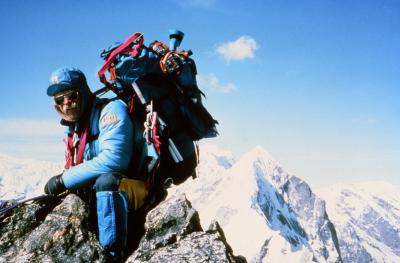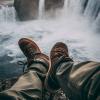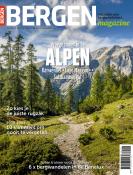
50 jaar Lowe Alpine - hoe het ooit begon
In 1934, sixteen year old Ralph Lowe and his uncle hitched up a buggy and drove from the range where they worked in St Anthony, Idaho to the west side of the Tetons to climb the Owen-Spalding route on the Grand Teton. It was to be the beginning of Ralph’s life long love of the outdoors and mountains in general, and of the Tetons in particular. It was a love that Ralph passed down to all his children, especially to his three sons Mike, Greg and Jeff.
The experience in the Tetons must have enthralled Ralph for he returned to the Grand Teton again and again over the next thirty years climbing there many times. He also grabbed every chance he could to climb in other areas. On one occasion in the late 1940s, well before the interstate era, he slipped away from work on a Friday afternoon and drove over 800 miles to Mt. Rainier. Arriving on the Saturday afternoon, he immediately began climbing the mountain, despite a fierce storm. After struggling through the night, he summited, descended and drove hell-bent back to Ogden, arriving just in time to saunter into work on Monday morning.
Ralph and his wife Elgene went on to raise eight children; four boys and four girls who all enjoyed the outdoors. However, for Jeff, Greg and Mike that interest quickly turned into a passion for mountaineering. In 1956, Ralph took his eldest son, Mike (then aged 10), up the Exum Ridge of the Grand Teton. In 1958, he returned to do this same ridge again but this time with his younger sons Greg (aged 8) and Jeff (aged 7), making Jeff the youngest person ever to do the climb.
 Climbing the Grand Teton with their dad was a rite of passage and over the next two decades climbing became a passion for Mike, Greg and Jeff, as they quickly developed into good rock climbers and mountaineers. By the time they had reached their early teens, their ability had surpassed their father’s.
Climbing the Grand Teton with their dad was a rite of passage and over the next two decades climbing became a passion for Mike, Greg and Jeff, as they quickly developed into good rock climbers and mountaineers. By the time they had reached their early teens, their ability had surpassed their father’s.
“ That might have bothered some fathers, but he was always excited about it,” Jeff recalls. “ He always encouraged us to do what we wanted, absolutely no limits. He really trusted us, but that’s because he always taught us that whatever happened we were responsible.” In 1979, Mike Lowe talked about those early days climbing. “ It has been twenty-two years since I found myself as a ten year old perched high on the Exum Ridge of the Grand Teton warming the early morning sun. I wasn’t sure then whether Jeff could hold my father, Ralph, should he fall as he inched his way out on the ledge known as Wallstreet. It quickly disappeared at his feet. The old angle piton at my waist and the quarter-inch goldline in my hands did not lend any particular reassurance to my body. My fears were settled only by the knowledge that I had held countless falls from our garage roof and had made numerous small climbs and rappels on the cliffs behind my home in Odgen with Dad. We travelled light with only small packs, five or six karabiners and few pitons.
It was years later, and a solo climb up the ridge before I realized the quarter-inch rope was there for my belay and experience and not really to hold Dad. But I learned with a heightened sense of responsibility and the knowledge that our lives were connected by a thin line and our actions. The next summer my younger brothers Jeff and Greg, were on the ridge at the earlier ages of 7 and 8. For us the climb of the Grand Teton was an early graduation into the ability to carry a pack, bivouac follow a route, tie our knots and set up our belays and rappels. Most of our climbing in the years to follow was on our own but with the support and encouragement of a father who put no limits on what we could attempt. His trust in our judgement made us feel the more responsible for our decisions. The skills and judgement learned in those early years became the basis for our pursuit of recreation, work and lifestyle. We’ve stayed with the mountains since then - each following their own ways and experiences. What we found has been good to us. We’ve visited incredible countries, had great adventures and along the way made mountaineering into a business and lifestyle.”
An Inventive Mind
As their skills grew; so did their interest in more demanding routes, which in turn required equipment simply not available in the late 1960s. For Greg, in particular, designing things had been an interest since childhood. As a kid, he was forever building telescopes, constructing model rockets or playing with chemistry sets. When he was only in second or third grade, he converted a toy cap gun into a real weapon. Since the local ammo shop wasn’t exactly keen to sell him catridges, he made his own gunpowder. In seventh grade, he took second place in the Utah state science fair.
When Greg turned his ingenuity towards inventing outdoor equipment, an impressive series of innovations and ideas soon emerged. When he wasn’t inventing, Greg was honing his climbing skills, including a first ascent in 1967 of Macabre Wall, a huge roof problem near Ogden (it was 20 years before the route had a second ascent - by Ken Gygi who rated it at 5.12c - possibly making it the most difficult free climb in the world in 1967). Greg remembers it as the hardest rock climb he had done without a fall. “It’s a lot harder than some of the more recent bouldering things I have done like Clever Lever,” Greg said afterwards, referring to the notorious 5.12 roof in Eldorado. Greg did the first free ascent of that route in 1976 - having climbed only a dozen pitches in the previous five years and not touched a rock in nine months. One day, on a whim, he tried it in his tennis shoes. After taking two falls, he decided it could be done. When he returned the next day with his rock shoes, the final holds were slimy and dripping water, yet he finishes the climb on his first try.
Limits are there to be broken
 Jeff, meanwhile, had become fascinated with alpine style in the Himalayas. “ I started to form this idea of a progression of climbs that would lead up to doing some of the harder and more beautiful routes on the highest peaks,” he says. The motivation, to him, was simple. “ The climbs I get the most from are the ones where I push myself. I need to do climbs that are my limit, or even a little beyond, so that I have to rise to the occasion. Otherwise it’s just another climb.”
Jeff, meanwhile, had become fascinated with alpine style in the Himalayas. “ I started to form this idea of a progression of climbs that would lead up to doing some of the harder and more beautiful routes on the highest peaks,” he says. The motivation, to him, was simple. “ The climbs I get the most from are the ones where I push myself. I need to do climbs that are my limit, or even a little beyond, so that I have to rise to the occasion. Otherwise it’s just another climb.”
Only a dozen lines in the world fitted Jeff’s definition of the ultimate alpine climb. “ The route must be on a peak that is 8,000 metres high, or close to it. It must have good rock, great technical difficulty, be long and sustained and, most importantly, take an elegant line. The south pillar of Nuptse is in that class, along with the west face of Gasherbrum IV, the west pillar on Makalu, the south face on Annapurna and a handful of others.” Some of the climbs Jeff has made in preparation for these ultimate routes have themselves become legendary. His first ascent, solo, of the south face of Ama Dablam and his almost successful ascent of the north ridge of Latok are both well known. Not as many people know of his long, hard free-climbs on alpine rock. Most satisfying for Jeff was his first free ascent of a 2000-foot pillar on 18,500-foot Puscanturpa Norte. Jeff free climbed the route in six hours, carefully belaying himself on the 5.10 crux sections. In 1990 he went on to free climb the Trango Tower in Pakistan with Catherine Destivelle.












